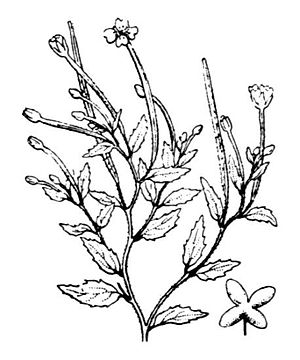Hill willowherb
| Hill willowherb | ||||||||||||
|---|---|---|---|---|---|---|---|---|---|---|---|---|

Hill willowherb ( Epilobium collinum ), illustration |
||||||||||||
| Systematics | ||||||||||||
|
||||||||||||
| Scientific name | ||||||||||||
| Epilobium collinum | ||||||||||||
| CCGmel. |
The hill willowherb ( Epilobium collinum ) is a species of willowherb ( Epilobium ) within the family of the evening primrose family (Onagraceae).
description
Vegetative characteristics
The hill willowherb is a perennial herbaceous plant and reaches heights of 10 to 40 centimeters. It has a short rhizome and no runners during flowering. At the root neck there are underground, mostly seated stick buds, from which rosettes are later formed. The stems are usually upright or ascending and branched from the base. They are stalk-round, with short hairs in the upper area.
The mostly opposite leaves up to the inflorescence are divided into a petiole and a leaf blade. The petiole is 0.5 to 2 millimeters long. The simple leaf blade is elongated to ovoid with a rounded base, with a length of 1 to 5, rarely 8 centimeters and a width of 0.5 to 1.5 centimeters. The leaf margin is serrated irregularly up to 0.5 millimeters long. On the underside of the leaf, the leaf margin and the nerves are finely haired, the upper side of the leaf appears glabrous, but is covered with microscopic glandular hairs.
Generative characteristics
The flowering period extends from June to September. The flowers are radial symmetry and have a long tube. The flower length is 4 to 6 millimeters. The buds are spherical to ovate and blunt. The sepals are 3 to 4 millimeters long and blunt. The rose-red crown is funnel-shaped and the petals are edged. The upright and bald stylus ends in a scar with four protruding branches.
The capsule fruit is hairy and non-glandular when pressed. With a length of about 1.1 millimeters, the seeds are narrowly obovate and blunt at the base. The seed coat is briefly papillary and reddish brown.
The number of chromosomes is 2n = 36.
ecology
The hill willowherb is a mesomorphic hemicryptophyte .
Self-pollination predominates , the flowers are visited by a few insects.
distribution
The hill willowherb occurs in Central Europe mainly in the south, in the north it is rare or absent.
It grows on sunny, stony places and in dry bushes, mainly on dry to moderately fresh, mostly lime-free silicate and red sandstone subsoil . It avoids lime, loves light and is an acid pointer. It occurs from the collines to the montane and subalpine, rarely also alpine altitudes . In Tyrol it rises to an altitude of 2000 meters. In the Allgäu Alps, it rises from 800 meters to an altitude of 1890 meters in the Vorarlberg part on the southern slope of the western Ochsenhofer Kopf near Mittelberg .
Phytosociological it is a trim characteristic species of Androsacetalia vandellii , but also occurs in societies of order Androsacetalia alpinae or Galiopsietalia segetum ago.
supporting documents
- Siegmund Seybold (Ed.): Schmeil-Fitschen interactive (CD-Rom), Quelle & Meyer, Wiebelsheim 2001/2002, ISBN 3-494-01327-6
- Manfred A. Fischer , Karl Oswald, Wolfgang Adler: Excursion flora for Austria, Liechtenstein and South Tyrol. 3rd, improved edition. State of Upper Austria, Biology Center of the Upper Austrian State Museums, Linz 2008, ISBN 978-3-85474-187-9 .
Individual evidence
- ↑ a b c Erich Oberdorfer : Plant-sociological excursion flora for Germany and neighboring areas . With the collaboration of Angelika Schwabe and Theo Müller. 8th, heavily revised and expanded edition. Eugen Ulmer, Stuttgart (Hohenheim) 2001, ISBN 3-8001-3131-5 , pp. 685 .
- ↑ Erhard Dörr, Wolfgang Lippert : Flora of the Allgäu and its surroundings. Volume 2, IHW, Eching 2004, ISBN 3-930167-61-1 , p. 248.
Web links
- Epilobium collinum CC Gmel., Hill willowherb. In: FloraWeb.de.
- Profile and distribution map for Bavaria . In: Botanical Information Hub of Bavaria .
- Hill willowherb . In: BiolFlor, the database of biological-ecological characteristics of the flora of Germany.
- Epilobium collinum CC Gmel. In: Info Flora , the national data and information center for Swiss flora . Retrieved December 29, 2015.
- Distribution in the northern hemisphere
- Data sheet distributed in France by Tela Botanica .
- Willowherb data sheet and pictures at: Flora-de: Flora von Deutschland